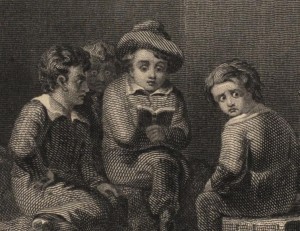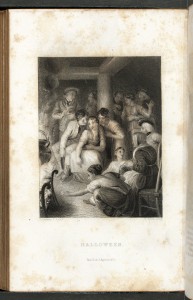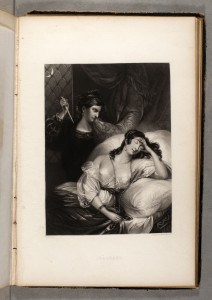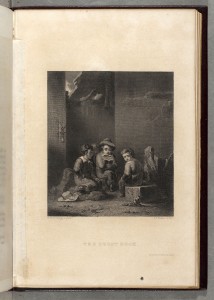 As readers of Past is Present are already aware, the Society’s Graphic Arts department is currently immersed in cataloging illustrations in our collection of gift books for the Prints in the Parlor project. Because the season of ghosts and goblins is now upon us as we near the end of October, we have been making particular note of those illustrations that have some relation to Halloween.
As readers of Past is Present are already aware, the Society’s Graphic Arts department is currently immersed in cataloging illustrations in our collection of gift books for the Prints in the Parlor project. Because the season of ghosts and goblins is now upon us as we near the end of October, we have been making particular note of those illustrations that have some relation to Halloween.
All Hallows Eve was not a particularly big holiday in America during the 1840s and 1850s, when most of the gift books were published, but there are a few mentions of the day. The illustration “Halloween” from The Mignonette (New York, c1856-57) is pretty typical of representations of the holiday.  It depicts young people and an elderly couple gathered around a fire. The evening was more for young adults, and was one filled with roasted chestnuts and corn, storytelling, and sparking (flirtations with the opposite sex), and not costumes and candy or spook-tacular gore.
It depicts young people and an elderly couple gathered around a fire. The evening was more for young adults, and was one filled with roasted chestnuts and corn, storytelling, and sparking (flirtations with the opposite sex), and not costumes and candy or spook-tacular gore.
However, there are many other examples of frightening images in American gift books that are not related to Halloween but instead illustrate the Gothic-style prose and poetry of the era. These include dramatic pictures of murder, war,  abuse, and revenge. An engraving of a woman with a knife entitled “Jealousy” from Gems of beauty (Boston, c1848) depicts a violent-looking woman about to stab her sleeping victim. Other illustrations include skeletons at parties, women buried alive, witches telling fortunes, and night scenes of shadowy city streets.
abuse, and revenge. An engraving of a woman with a knife entitled “Jealousy” from Gems of beauty (Boston, c1848) depicts a violent-looking woman about to stab her sleeping victim. Other illustrations include skeletons at parties, women buried alive, witches telling fortunes, and night scenes of shadowy city streets.
Finally, there is the wonderful image of “The Ghost Book,” which depicts a group of small boys gathered around a central child who is reading. Their eyes are wide with horror as they look around the shadowy yard. This image first appears in a Philadelphia annual The Gift (ca. 1839), and accompanies a story by Eliza Leslie about a diary kept by a traveler staying in a haunted bedroom. The boys have found the diary and are reading about spirits hiding in a dark closet under the eaves and pools of old blood from a murder committed long ago. In the end it turns out the diarist, an itinerant artist, was writing a rough draft of a story he hoped to have published in a “periodical of the day.” The boys are greatly relieved.

The image was re-used five years later in the 1844 Literary Souvenir, also published in Philadelphia, but the title was changed to “The Fright” in order to better illustrate a tale of the overactive imagination of boys written by George G. White. In White’s version, the central boy is described as
too strongly addicted to the marvelous. His brain was half turned from listening to the tales of an old nurse of the family, and reading romances and ballads.
This time the book the boys read is a cheaply printed text, purchased in town, Tales of Terror or the Mysteries of Magic. The story does not end well for the main character. He is so frightened by the words he reads aloud that
the shock had been too much for his reason. He had fallen victim to the follies of superstition, and remained an idiot for life.
Gads! What would he have made of the shrieking dementors in Harry Potter? All in all, the gift books provide us with evidence of nineteenth-century concepts of fear and darkness and ghosts and naughty boys – what more could we ask to mark the arrival of Halloween in 2010?
